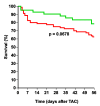Selective HDL-Raising Human Apo A-I Gene Therapy Counteracts Cardiac Hypertrophy, Reduces Myocardial Fibrosis, and Improves Cardiac Function in Mice with Chronic Pressure Overload
- PMID: 28930153
- PMCID: PMC5618660
- DOI: 10.3390/ijms18092012
Selective HDL-Raising Human Apo A-I Gene Therapy Counteracts Cardiac Hypertrophy, Reduces Myocardial Fibrosis, and Improves Cardiac Function in Mice with Chronic Pressure Overload
Abstract
Epidemiological studies support an independent inverse association between high-density lipoprotein (HDL) cholesterol levels and heart failure incidence. The effect of selective HDL-raising adeno-associated viral serotype 8-human apolipoprotein (apo) A-I (AAV8-A-I) gene transfer on cardiac remodeling induced by transverse aortic constriction (TAC) was evaluated in C57BL/6 low-density lipoprotein receptor-deficient mice. Septal wall thickness and cardiomyocyte cross-sectional area were reduced by 16.5% (p < 0.001) and by 13.8% (p < 0.01), respectively, eight weeks after TAC in AAV8-A-I mice (n = 24) compared to control mice (n = 39). Myocardial capillary density was 1.11-fold (p < 0.05) higher and interstitial cardiac fibrosis was 45.3% (p < 0.001) lower in AAV8-A-I TAC mice than in control TAC mice. Lung weight and atrial weight were significantly increased in control TAC mice compared to control sham mice, but were not increased in AAV8-A-I TAC mice. The peak rate of isovolumetric contraction was 1.19-fold (p < 0.01) higher in AAV8-A-I TAC mice (n = 17) than in control TAC mice (n = 29). Diastolic function was also significantly enhanced in AAV8-A-I TAC mice compared to control TAC mice. Nitro-oxidative stress and apoptosis were significantly reduced in the myocardium of AAV8-A-I TAC mice compared to control TAC mice. In conclusion, selective HDL-raising human apo A-I gene transfer potently counteracts the development of pressure overload-induced cardiomyopathy.
Keywords: apolipoprotein A-I; cardiac function; cardiac hypertrophy; gene therapy; heart failure; high-density lipoproteins; oxidative stress; pressure overload.
Conflict of interest statement
The authors declare no conflict of interest.
Figures




Similar articles
-
Cholesterol-Lowering Gene Therapy Counteracts the Development of Non-ischemic Cardiomyopathy in Mice.Mol Ther. 2017 Nov 1;25(11):2513-2525. doi: 10.1016/j.ymthe.2017.07.017. Epub 2017 Aug 1. Mol Ther. 2017. PMID: 28822689 Free PMC article.
-
Selective homocysteine-lowering gene transfer attenuates pressure overload-induced cardiomyopathy via reduced oxidative stress.J Mol Med (Berl). 2015 Jun;93(6):609-18. doi: 10.1007/s00109-015-1281-3. Epub 2015 Apr 11. J Mol Med (Berl). 2015. PMID: 25860230
-
Cholesterol lowering attenuates pressure overload-induced heart failure in mice with mild hypercholesterolemia.Aging (Albany NY). 2019 Sep 4;11(17):6872-6891. doi: 10.18632/aging.102218. Epub 2019 Sep 4. Aging (Albany NY). 2019. PMID: 31484164 Free PMC article.
-
[Roles of Sodium-Glucose Cotransporter 1 (SGLT1) in the Induction of Cardiac Remodeling].Yakugaku Zasshi. 2018;138(7):939-943. doi: 10.1248/yakushi.17-00223-2. Yakugaku Zasshi. 2018. PMID: 29962473 Review. Japanese.
-
Gene therapy to improve high-density lipoprotein metabolism and function.Curr Pharm Des. 2010 May;16(13):1531-44. doi: 10.2174/138161210791050997. Curr Pharm Des. 2010. PMID: 20196736 Review.
Cited by
-
Association of High apoB/apoA1 Ratio with Increased Erythrocytes, Platelet/Lymphocyte Ratio, D-dimer, Uric Acid and Cardiac Remodeling in Elderly Heart Failure Patients: A Retrospective Study.Int J Gen Med. 2024 May 15;17:2151-2161. doi: 10.2147/IJGM.S465053. eCollection 2024. Int J Gen Med. 2024. PMID: 38766597 Free PMC article.
-
HDL-replacement therapy: From traditional to emerging clinical applications.Atheroscler Plus. 2025 Feb 25;59:68-79. doi: 10.1016/j.athplu.2025.02.001. eCollection 2025 Mar. Atheroscler Plus. 2025. PMID: 40103705 Free PMC article. Review.
-
HDL subclasses and mortality in acute heart failure patients.Clin Chim Acta. 2019 Mar;490:81-87. doi: 10.1016/j.cca.2018.12.020. Epub 2018 Dec 19. Clin Chim Acta. 2019. PMID: 30578754 Free PMC article.
-
Reconstituted HDL (Milano) Treatment Efficaciously Reverses Heart Failure with Preserved Ejection Fraction in Mice.Int J Mol Sci. 2018 Oct 30;19(11):3399. doi: 10.3390/ijms19113399. Int J Mol Sci. 2018. PMID: 30380754 Free PMC article.
-
Bakuchiol protects against pathological cardiac hypertrophy by blocking NF-κB signaling pathway.Biosci Rep. 2018 Oct 31;38(5):BSR20181043. doi: 10.1042/BSR20181043. Print 2018 Oct 31. Biosci Rep. 2018. PMID: 30242058 Free PMC article.
References
-
- Van Linthout S., Frias M., Singh N., de Geest B. Therapeutic potential of HDL in cardioprotection and tissue repair. Handb. Exp. Pharmacol. 2015;224:527–565. - PubMed
MeSH terms
Substances
LinkOut - more resources
Full Text Sources
Other Literature Sources
Medical
Miscellaneous

